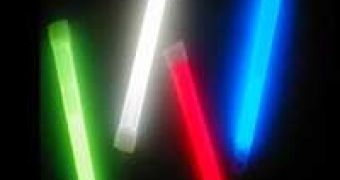What's better than having a light source that uses neither batteries nor light bulbs, gives off an intense light emission, lights up no matter if it's held underwater or in plain air and can be carried wherever you may go? If I were to answer this question I would say nothing. Light sticks have been put on the market more than two decades ago and have since become the main attraction for children, experienced underwater divers and campers alike. Sure, they may look at first as some kind of supernatural or science fiction devices, but in fact light sticks are extremely simple and easy to use.
Currently, light sources can be divided into three categories according to the energy they use in light conversion processes. This way we have incandescent light bulbs, which convert electricity into heat in order to create a bright light emission, fluorescent and phosphorescent sources that give off light in response to the inputted radiation energy and laser sources, which, as their name states, produce amplified light emissions through stimulated emission of radiation.
All of these processes rely on the power of the atoms used in order to release light. Atoms can be brought into an excited state either by inputting energy through electricity, radiation or a chemical reaction. In response to the energy excess atoms start emitting subatomic particles known as photons, the basic constituents of light.
Chemiluminescence
Light sticks work according to the same principle, only that the energy required to create a light emission is provided by a chemical reaction between two or more chemical compounds. Basically the light stick is formed of two envelopes containing two chemical compounds. The outer envelope is a plastic casing containing an inner glass vial. The glass vial is filled with hydrogen peroxide solution, also called the activator, while the plastic casing contains phenyl oxalate ester and a fluorescent dye, which gives the color of the light.
To activate the chemical reaction between the activator and the phenyl oxalate solution, one only has to bend the light stick in order to break the glass vial. At this point, the two substances start to mix and the chemical reaction is initiated. The hydrogen peroxide activator oxidizes the phenyl oxalate ester, resulting in a chemical compound known as phenol plus a peroxyacid ester. The peroxyacid ester is unstable and starts decomposing into more phenol and cyclic peroxy compound.
The chemical reaction further advances with decomposing the cyclic peroxy to carbon dioxide, which takes place with the release of energy. This energy is transferred to the dye substance, which raises the energy of the atoms to a higher state then jumping back to a lower energy state by emitting light. In case the fragile glass vile accidentally breaks, the energy release can be stopped by placing the light stick in a cold environment, such as a freezer for example.

 14 DAY TRIAL //
14 DAY TRIAL //